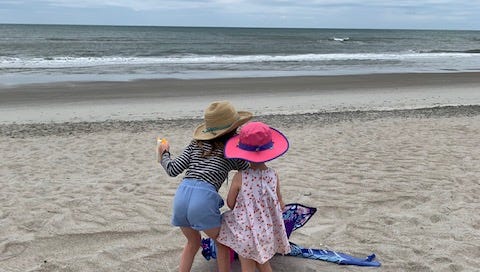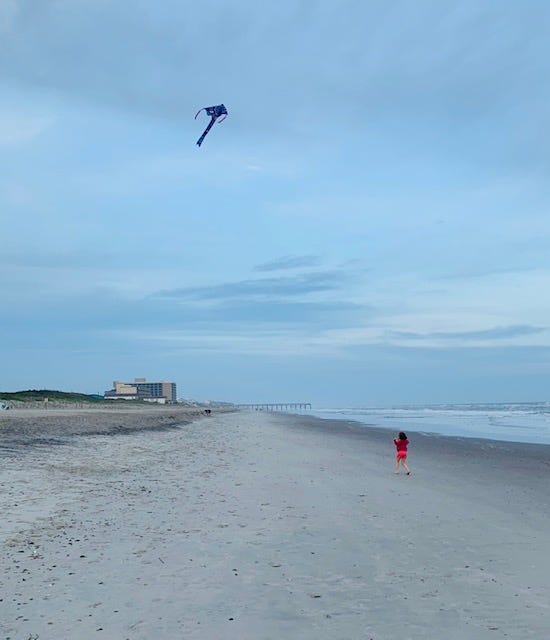This week, my family took our first beach trip since the pandemic started. I’d scheduled the trip once Richard and I were fully vaccinated, knowing that Mother’s Day was coming up, plus the end of a semester that felt twice as long as a normal semester. Didn’t we deserve to celebrate a little? I called my favorite 1960’s dog-friendly beach motel (we don’t have a dog, we just like them) and told them we’d take “whatever stretch of days you have in May.” They had three nights in a single room plus kitchenette, with a balcony overlooking the ocean. Done.
Like Bea, I packed an ambitious pile of books. Ted Chiang’s Stories of Your Life and Others, Natalia Ginzburg’s The Manzoni Family, and Hernan Diaz’s In the Distance, a gift from a recent MFA graduate who always recommends great books. Unlike Bea, I did not read the books I brought (I think she read hers in the car) because I was busy. Trying to coax Harriet out of the baby pool she waded into with her clothes on. Chasing Harriet down the beach. Chasing after Beatrice’s kite, which kept getting away from us in the wild winds. Trying to explain to Harriet that no, she could not be alone in the ocean (“but I want to be alone!”). Watching Bea swim underwater (“Behold me!” she now likes to say, before doing something impressive). Checking and responding to work emails (it wasn’t quite the end of the semester, after all).
Part of me must have known it would be like this. At the last minute, I also packed Alice Munro’s The Moons of Jupiter, a book I knew I could reread and enjoy while also attending to all of the above.
From the edge of the pool Bea asked me what it was about. “Hmmm,” I said. “Being a woman, getting older, and … dealing with all of that? Also, men being crummy.”
She nodded sagely.
“In Canada,” I added.
I love Alice Munro’s stories because they are so incredibly closely observed and insightful, never sentimental, always honest.
‘If this is love I want no part of it […] She doesn’t enjoy anything and if you gave her the choice she would like best to lie down in a dark room with a cloth over her eyes and not see anyone or do anything. This is an intelligent women who used to believe in freedom.’
Now that I think of it, she looked splendid. I wish I had met her somewhere else. I wish I had appreciated her as she deserved. I wish that everything had gone differently.
It was deathly cold in there, in the turkey’s dark insides.
A bracing thing to read when you are also closely observing: Oh, you’re going to gallop into the ocean? I don’t think so. You’re going to inch over into the deep end? Not on my watch.
Moms have a lot to be vigilant about these days: Masks worn correctly. Six feet of distance. Hand sanitizer in the car. When exactly to switch off the news program. How much to say about hurricanes, tornadoes, windstorms, wildfires, water pollution, police brutality.
A couple of weeks ago, I read Lizzie Widdicombe’s “The Moms Who Are Battling Climate Change” in the New Yorker online, an interview with several women climate scientists who are working on an initiative to persuade mothers to take action on climate change. One scientist reported that sending her children outside to ride bikes in Tucson had led to heatstroke; another was fearful about the Colorado fire-smoke her children were inhaling. But they all felt that if they communicated with other moms, they could make a difference. As Dr. Emily Fischer, atmospheric scientist at Colorado State and one of the “Science Moms,” said in the piece, “I think that as soon as moms know this is urgent, and it has to be dealt with now—not next year—they’ll do it.”
This belief is backed up by research—women, particularly mothers, are far more persuadable about the need to do something about climate change than men. On average, they are more likely to believe in climate change, and are more stressed about it too (which makes sense, given that they are more likely to be hurt by its effects sooner). Still, when I clicked through to the Science Moms website, I felt a sinking defeat when I saw “the facts” (a debunking of myths like “climate change is a natural phenomenon”) and “resources” (four children’s books, five books for adults). I felt disappointed, I suppose, that these smart, accomplished women were lowering themselves to a fight started by men, industrialists, liars—that before we can even make a change we have to convince people that this change is necessary.
But that’s part of being vigilant. Which is a quality necessary for most things that matter. Like keeping your kite aloft on a windy day.
Bea’s guide to flying a kite:
1. Stand in a comfortable place with your back to the wind.
2. You don’t want to be around too many trees, and it’s best if you’re near the ocean, water, or a big field.
3. Unravel a lot of string.
4. Have one person (maybe your mom) hold your kite. Then, run into the wind until the string is taut.
5. Yell to your mom to release the kite. This might take a few tries. Eventually, with enough wind, the kite will lift into the air. Unravel a little more string—but not too much.
Tip: If your kite seems to go down and you’re near the ocean, go near the ocean and that will push the kite away, back where you want it to go.
6. Hold on tight!
7. The wind decides where the kite goes. The most important rule is… have fun!
Happy Mother’s Day, with love from Belle & Bea.
P.S. (a joke from Bea):
What does an octopus use to read?
A: SEA-GLASSES!






Thank you Belle and Bea!